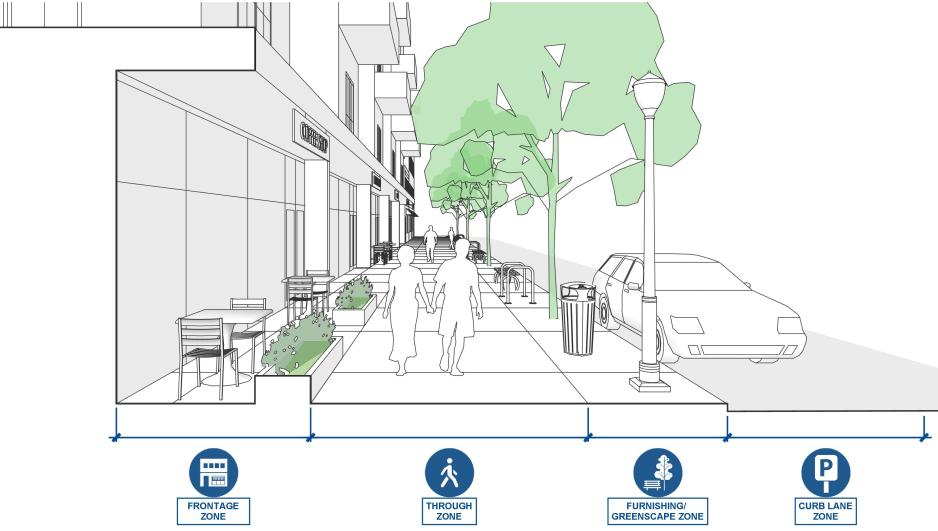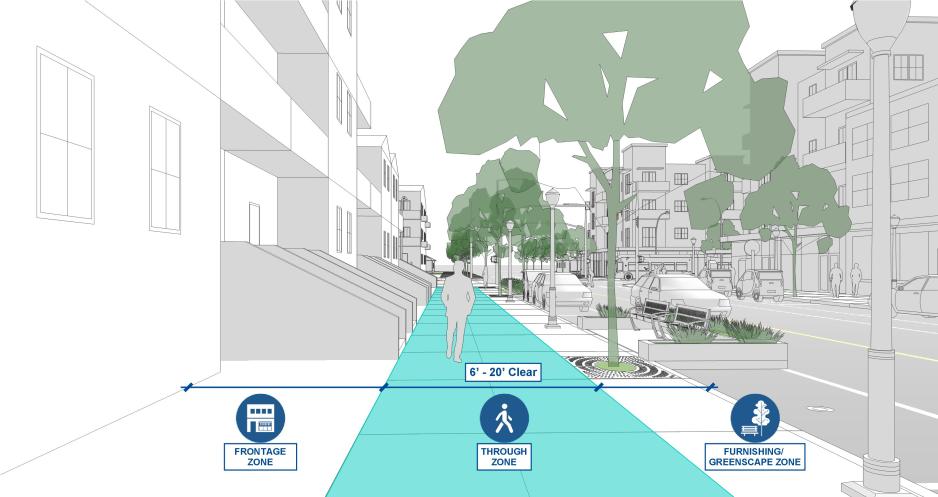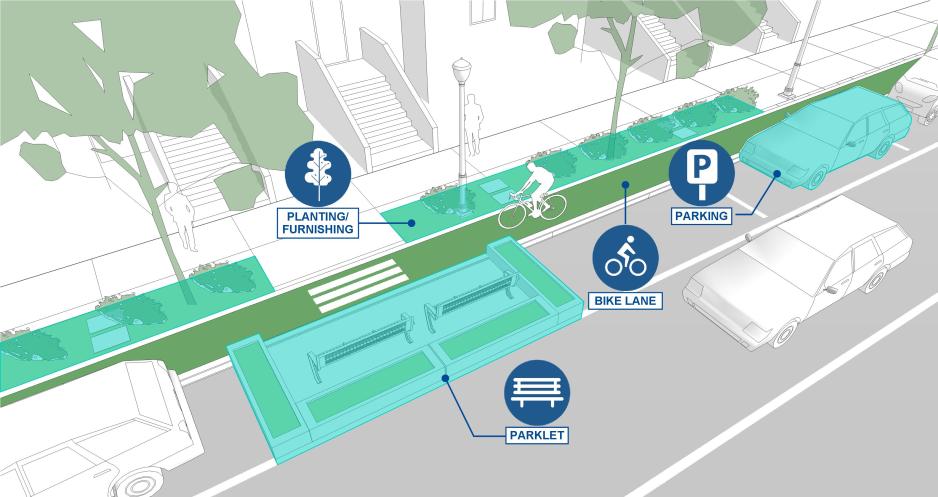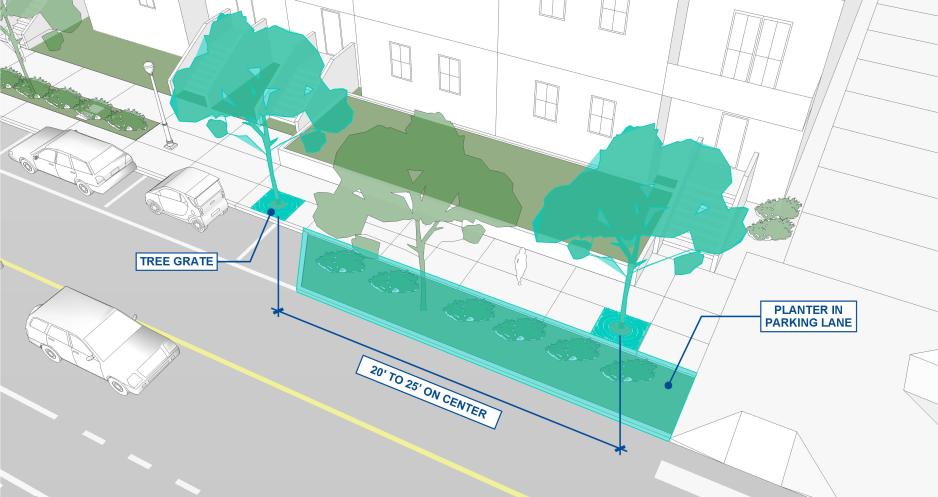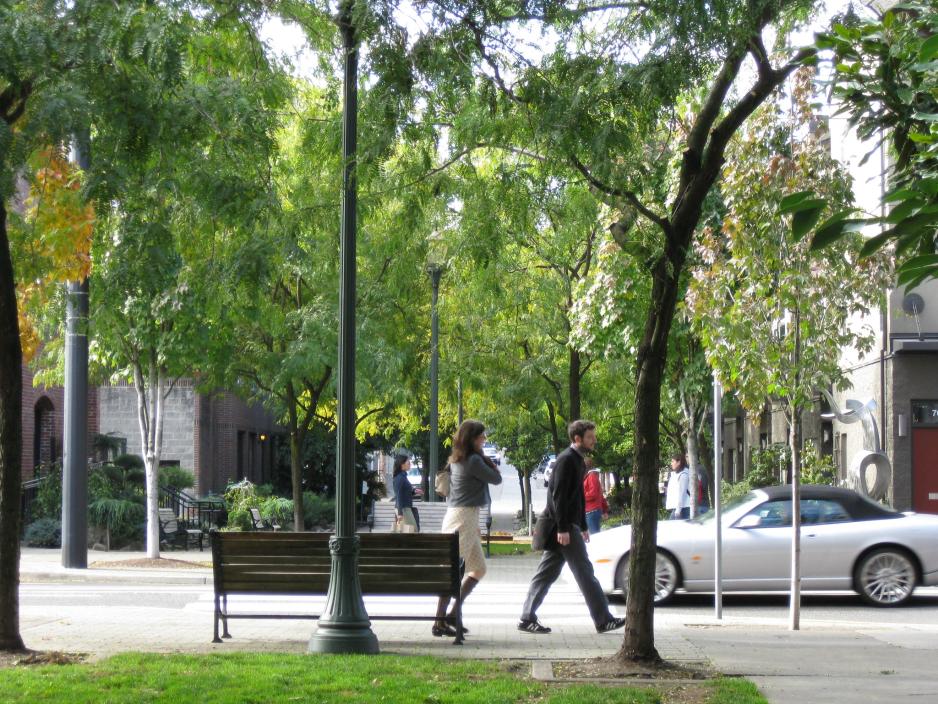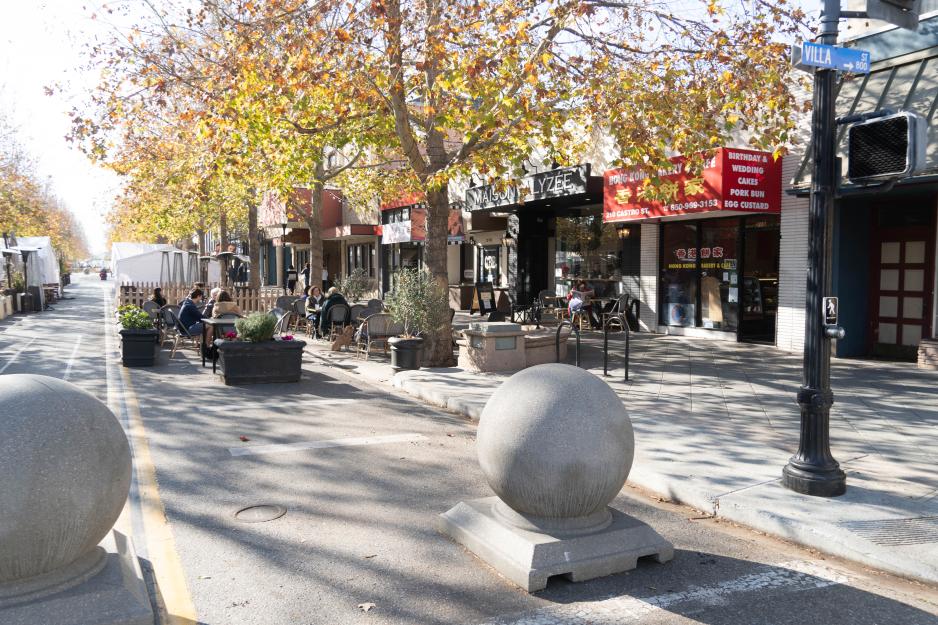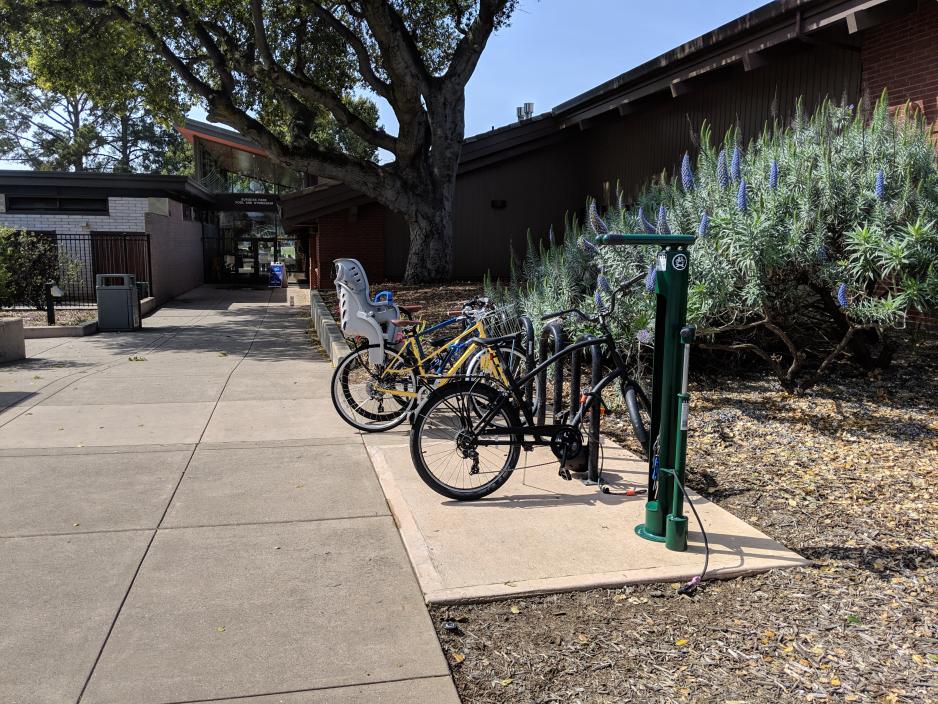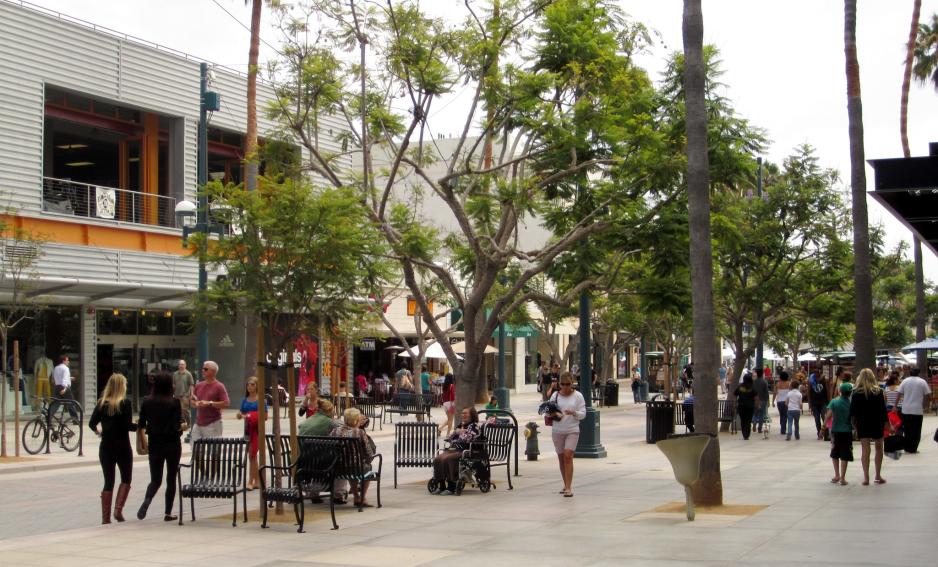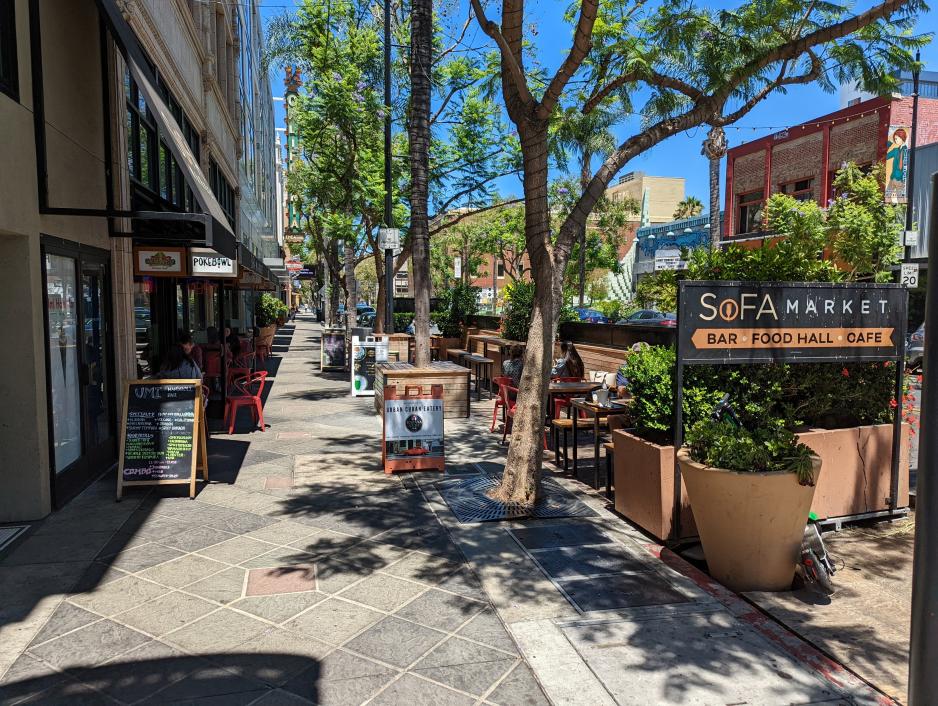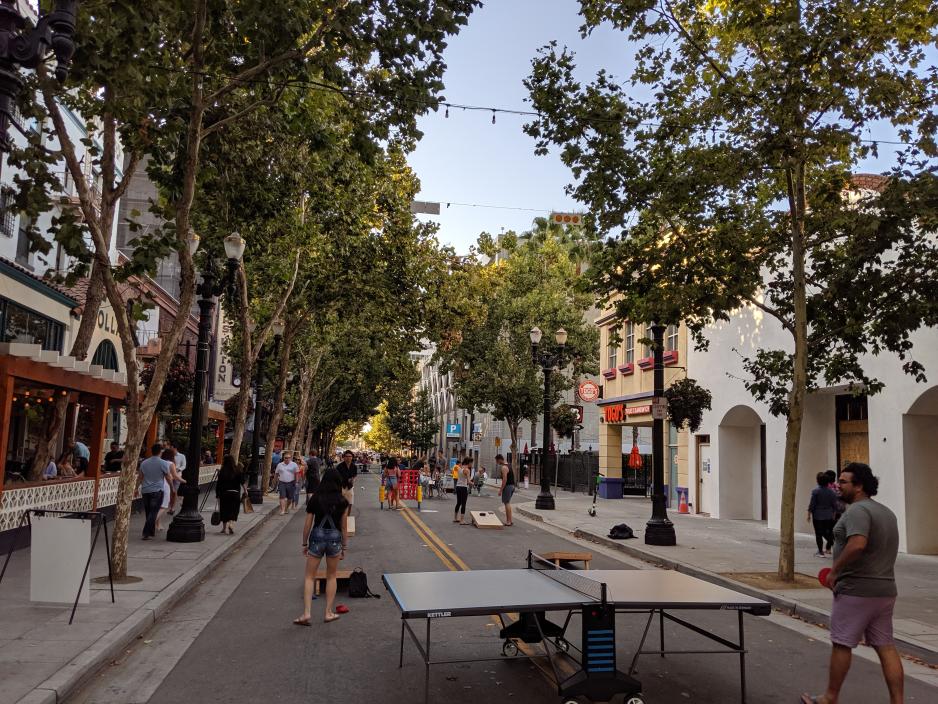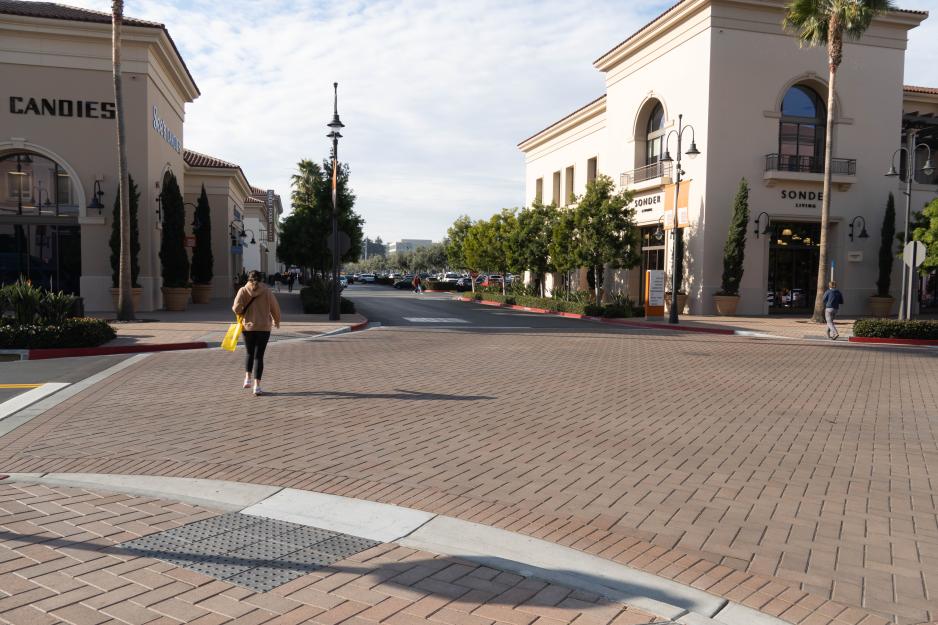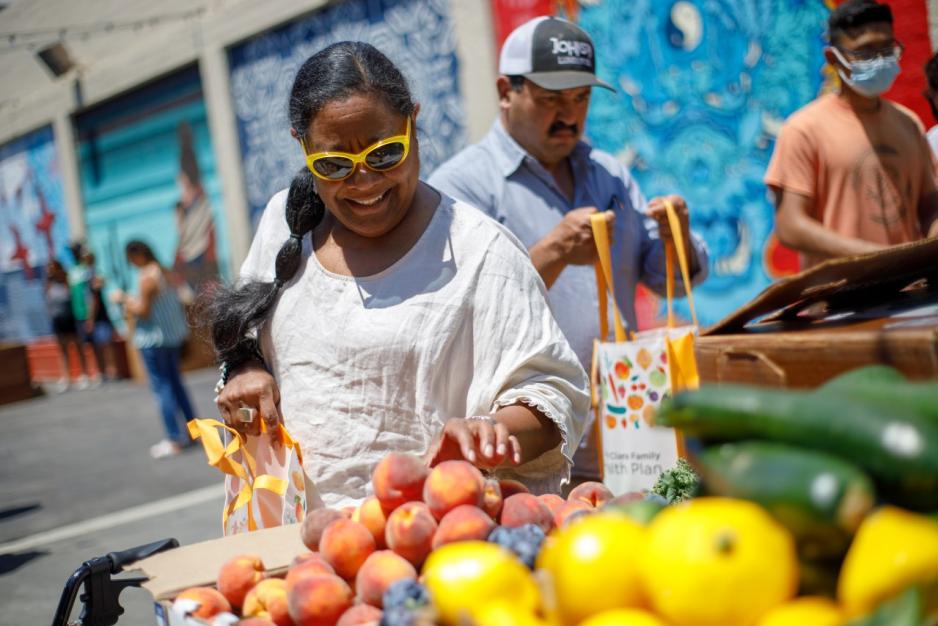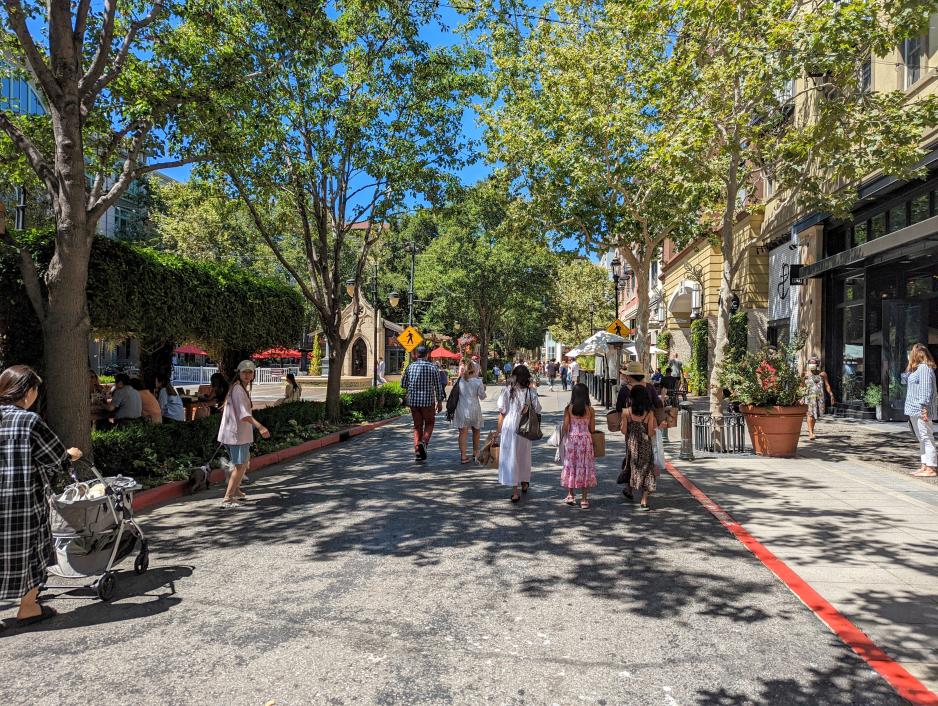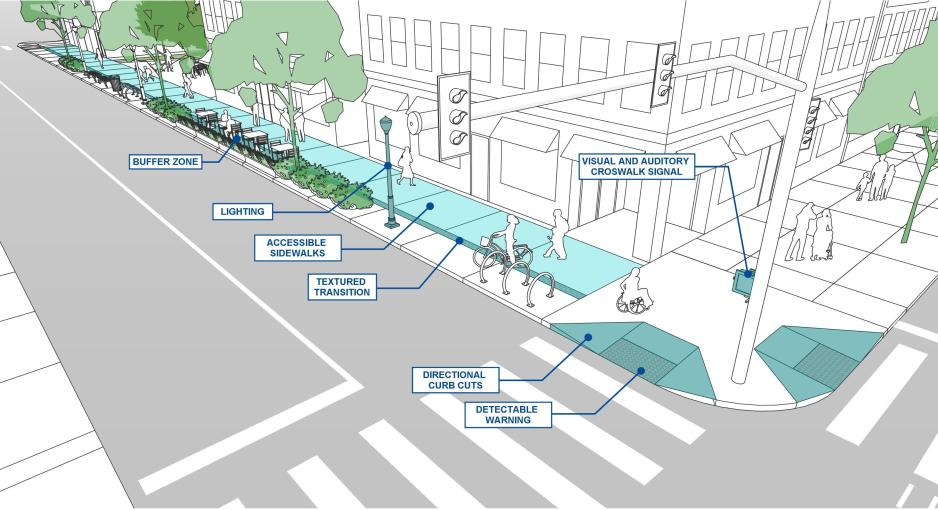A well-designed pedestrian environment is the foundation for safe, active, livable, and economically-vibrant communities. Pedestrian-oriented places encourage walking and exploration, enlivening public spaces. Safe, convenient, and comfortable pedestrian infrastructure is essential to support transit. In addition, pedestrian amenities make a critical difference in the safety, comfort, and mobility of those who may not have the option of driving: the elderly, the disabled, children, and lower-income people.
The pedestrian environment is the interface between the adjacent land use and the travelway and includes on-street parking, curb and gutter, sidewalk zones, and bus stops. The following are recommendations to enhance the safety, comfort, clarity, aesthetic appeal, and interest of the pedestrian environment.
Provide wide sidewalks with unobstructed through zones. The through zone is the part of the sidewalk reserved for pedestrian movement along the street.
- Sidewalk widths should be in the range of 6 to 20 feet with minimum 6 foot through zone. In residential areas, a six-foot wide sidewalk is the minimum width. In downtowns or mixed-use areas, wider sidewalks should be provided and designed as part of the public space and foreground for the buildings. In commercial areas with high pedestrian volumes (>100 pedestrians per hour) or in front of major attractors, sidewalks should be a minimum of 12 feet and as wide as 20 feet.
- Where right-of-way space is constrained, widen sidewalks at their most congested locations such as bus stops, at building entrances, and resting areas. Use curb extensions or building set-backs to achieve appropriate sidewalk width.
- Locate amenities outside of the through zone so as not to obstruct safe movement. Typically, the furnishing zone between the curb zone and the through zone contains light poles, furnishing, plantings and utility boxes.
Protect pedestrians from traffic. A physical buffer between pedestrians and moving vehicles increases the comfort of the pedestrian environment. The furnishing zone, curb zone and curb lane provide space for signs, utilities, planting and street furniture.
- Use the furnishing zone to provide amenities for pedestrians. Benches, trash receptacles, bike racks, planters, and planting strips all help improve the comfort of pedestrians.
- Use the curb lane to buffer pedestrians from traffic. Parking, parklets, raised planters, bicycle parking, bikeshare docking stations and similar objects buffer pedestrians from traffic. To ensure adequate sight distance, these objects should not be located immediately adjacent to intersections or pedestrian crossings. Sight distances should be calculated by a traffic engineer, taking into account location specific characteristics. Generally, pedestrian visibility calls for a minimum of no parallel parking within 20 feet of crosswalks at intersections on streets with speeds 25 mph or less, 30 feet for speeds between 26 mph and 35 mph, within 50 feet for speeds of 35 to 45 mph, and within 100 feet for speeds over 45 mph as well as for mid-block crossings.
- Provide a planting strip in the furnishing zone on streets where few people need to walk from the curb to the adjacent building, such as residential neighborhoods. Where on-street parking is provided, create periodic gaps to allow access from the parking to the through zone.
- Install separated bikeways. Separated bikeways, also known as cycletracks or protected bike lanes, use a vertical element to separate bicyclist from adjacent moving vehicles. When built at sidewalk level, bikeways become part of the pedestrian environment.
- Protect pedestrians by lowering speeds. On very-low-speed streets the sidewalk and travelway may be at the same grade but visually separated using special materials or paving, or physically separated with bollards or planters. The separation must be detectable by people with visual impairments.
Provide planting in the right-of-way. Planting buffers pedestrians from traffic, shades and cools the immediate vicinity, provides urban habitat, and when integrated into green stormwater infrastructure, catches and filters stormwater.
- Plant street trees. Trees should be planted at 25 to 50-foot intervals, depending on species, to form a continuous canopy over the sidewalk at maturity. Large deciduous shade trees of 50 to 70 feet at maturity should be implemented where space allows. Branching should be minimum 7 minimum height above the sidewalk when planted, and preferably 15 feet at maturity. On wide streets, plant trees in raised medians to provide a more expansive canopy.
- Get creative in tight spaces. In constrained right-of-way, use planters in the parking lane, either through construction of curb extensions or with stand-alone planters separated from the curb to allow drainage. Use ADA-compliant tree grates where tree wells encroach on the throughway zone.
- Modify streetscape treatment at transit stops. Provide an ADA-compliant hard surface for customer boarding and alighting. Avoid placing trees adjacent to bus stops as branches can damage delicate equipment on top of buses. If trees are strongly desired, work with the transit agency to determine how far back from the curb to plant the trees.
- Mitigate unintentional impacts. Ensure vegetation does not encroach on sidewalk through zones or bikeways. Ensure tree canopy does not block pedestrian scale street lighting at maturity. Ensure there is ample space for tree roots to grow and install soil cells, structural soil and root barriers to prevent roots from uplifting sidewalks.
- Prioritize street trees and street tree maintenance in low-income, minority communities. Studies have found street trees are distributed inequitably, resulting in higher temperatures and worse health outcomes. The poorest communities have 41% less tree cover. Whiter, wealthier neighborhoods with older residents are more likely to have higher amounts of tree cover.
Provide pedestrian amenities and create visual interest. A visually interesting pedestrian environment is necessary for a high-quality pedestrian experience. Details are easily perceived at walking speeds and can make a walk seem shorter. Some amenities such as lighting, benches, and trash receptacles are primarily functional, while others are primarily aesthetic.
- Provide a variety of planting for shade, aesthetics, and urban ecology.
- Provide lighting focused on human comfort and scale.
- Provide seating in the form of benches, seat walls, railings, and movable chairs.
- Provide clear signage and information kiosks that direct people to major activity centers and amenities .
- Provide trash receptacles and recycling bins near entrances and transit stops.
- Provide bike and scooter parking, including shared mobility parking near entrances and transit stops.
- Provide retail and food service.
- Provide public art on buildings and in the streetscape.
- Provide restrooms.
- Provide shade with street trees, awnings, canopies, and transit shelters.
- Provide water fountains or hydration stations.
Design and provide streetscape amenities consistent with the level of use of the street. Quiet residential streets may require only trees and lighting, while multimodal streets may need trees, lighting, site furniture, and signage.
Use alternative paving surfaces and materials. ADA- compliant materials such as brick, pavers, stamped and colored concrete provide visual interest, signal to pedestrians they are welcome, and when integrated into crosswalks or driveways, can cue drivers to expect pedestrians.
Encourage gathering. Create areas that can support street vending, entertainment, and casual gathering spots.
Provide pedestrian-scaled street lighting. Light walkways and pedestrian paths.
- Space light fixtures to provide consistent illumination, appropriate for the width of the sidewalk or pathway. Provide a minimum lighting level of lighting between 5 and 10 lux, depending on the surrounding land use and pedestrian activity levels. Tunnels and staircases should have higher lux. A Virginia Tech Transportation Institute study found that 20 lux illumination was necessary for a driver to detect a pedestrian in a crosswalk. Use light fixtures that are eight to 18 feet in height, with lighting elements that provide a full spectrum of light so that colors are realistic at night.
- Choose light poles that integrate with the rest of the street character. Decorative light poles contribute to visual interest.
- Consider tree canopy when placing light fixtures. Consider the height of the tree at maturity. If light obstruction occurs or will occur, consider additional light fixtures to illuminate the shadows.
- Select dark sky friendly fixtures that direct most light downward, turn off when not needed, and adjust light level. Selecting dark sky friendly fixtures reduces light pollution, minimizes the negative effect on night navigation for birds, improves tree growth and improves driver and pedestrian safety. To reduce impacts on wildlife, the International Dark-Sky Association recommends warm light with a color temperature of no more than 3000 Kelvins. For some sensitive wildlife, a narrow-spectrum amber LED may be best.
- Provide decorative lighting in gathering places. This could include string lights wrapped around trees, spotlights to highlight architecture or trees, fountains, or public art with integrated lighting.
Design the pedestrian realm for all abilities.
- Accommodate the needs of people with visual, auditory, mobility, and other impairments when designing the pedestrian environment.
- Seek input from people with disabilities. When planning new, uncommon streetscape features, such as protected intersections, bus boarding islands, shared streets, or bioswales, seek input from local disability advisory committees and organizations that work with people with visual, auditory, mobility, and other impairments to understand the impact on the pedestrian environment. Follow all regulatory requirements and required consultation when designing.
